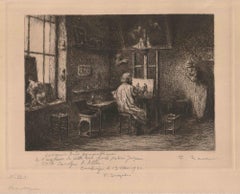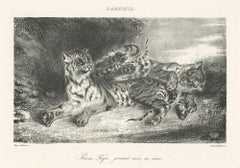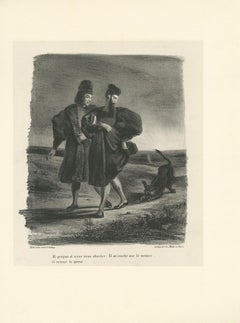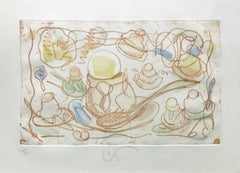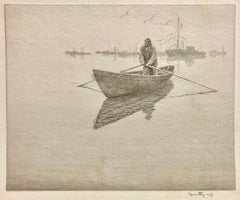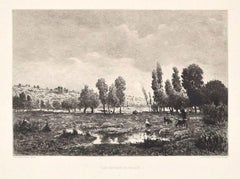Barbizon School Figurative Prints
to
4
15
8
12
11
22
1
Overall Height
to
Overall Width
to
12,616
7,039
2,602
2,218
2,018
841
707
556
362
298
272
106
83
23
12
8
5
5
5
4
4
3
2
2
2
2
2
2
1
1
1
1
1
1
22
1
1
3
3
2
2
1
14
8
8
4
3
Style: Barbizon School
Returnable Items Only
L'Abreuvoir - Etching after Jules Dupré - 19th Century
By Jules Dupré
Located in Roma, IT
L'Abreuvoir is an Etching print on paper realized by After Jules Dupré in the 1870s.
Titled and signed on the plate.
The artwork is in good conditions.
Category
19th Century Barbizon School Figurative Prints
Materials
Etching
Connais-tu le Pays (Primavera) apres J. Rolshoven (Do you Know the Country)
Located in Fairlawn, OH
Connais-tu le Pays (Primavera) apres J. Rolshoven
(Do you Know the Country -Spring)
Etching, 1889
Signed "Julius Rolshoven...
Category
1880s Barbizon School Figurative Prints
Materials
Etching
Millet in his Studio
Located in Middletown, NY
A touching scene of a young woman posing before Millet, modeling the female figure which would appear in his masterpiece painting L'Angelus. The painting depicts two peasants bowing ...
Category
Late 19th Century Barbizon School Figurative Prints
Materials
Handmade Paper
Jeune Tigre jouant avec sa mère (Young Tiger playing with its mother)
Located in Middletown, NY
Lithograph on on white wove paper, 4 1/2 x 7 3/8 inches (112 x 187 mm), wide margins. First state (of 6). A very good impression with minor scattered spots of very light discoloration.
[Delteil 91.1]
__________
At an early age Delacroix became a lover of music and literature and had been drawing from the time he entered school. He expected painting would be a hobby, but on the death of his father he found he had to make his own way in life. In 1817 he entered the studio of Pierre-Narcisse Guerin; amongst his fellow pupils was Gericault. His first exhibited work was Dante and Virgil...
Category
Mid-19th Century Barbizon School Figurative Prints
Materials
Handmade Paper, Lithograph
Arc de Triomphe de L'Étoile
Located in Middletown, NY
from "Paris dans sa Splendeur: Monuments, Vues, Scènes Historiques, Descriptions et Histoire."
Lithograph and engraving with hand coloring in watercolor on cream wove paper, 9 3/8 x ...
Category
Mid-19th Century Barbizon School Figurative Prints
Materials
Watercolor, Handmade Paper, Engraving, Lithograph
Faust, Méphistophélès et le Barbet / Faust, Méphistophélès and the Water Spaniel
Located in Middletown, NY
Lithograph on Chine appliqué, 9 1/4 x 8 1/8 inches (235 x 206 mm), full margins. First state (of 4). Extremely minor uniform age tone, otherwise in good condition. A superb, richly-inked impression.
[Delteil 61.1]
______
At an early age Delacroix became a lover of music and literature and had been drawing from the time he entered school. He expected painting would be a hobby, but on the death of his father he found he had to make his own way in life. In 1817 he entered the studio of Pierre-Narcisse Guerin; amongst his fellow pupils was Gericault. His first exhibited work was Dante and Virgil...
Category
Early 19th Century Barbizon School Figurative Prints
Materials
Handmade Paper, Lithograph
The Wild Cat (Chat Sauvage)
By Karl Bodmer
Located in Middletown, NY
Etching on cream laid paper, full margins. From Eaux-Fortes Animaux & Paysages. [Beraldi II.140.34] Henri Béraldi Les graveurs du XIXe siècle: Guide de l'amateur d'estampes modernes. Librairie L. Conquet, vol. XII, Paris, 1885–1892, cat. no. 34, p. 140.
__________
Well known in his native Germany as a watercolorist, Karl Bodmer had a rich experience exploring in North America in the 19th century, accompanying German explorer Prince Maximilian zu Wied-Neuwied as the official artist on an expedition which toured the Missouri River...
Category
Mid-19th Century Barbizon School Figurative Prints
Materials
Laid Paper, Etching
Wild Boar, from Eaux-Fortes Animaux & Paysages: Sanglier
By Karl Bodmer
Located in Middletown, NY
Etching on cream laid paper, 4 3/4 x 6 inches (120 × 152 mm), full margins. Minor uniform age tone, and a 2-inch x 1-inch margin loss, at top extreme sheet edge, well outside of imag...
Category
1860s Barbizon School Figurative Prints
Materials
Laid Paper, Etching
A Domestic Cat Playing with a Garter Snake, from Eaux-Fortes Animaux & Paysages
By Karl Bodmer
Located in Middletown, NY
Etching on cream laid paper, 6 1/8 x 4 3/4 inches (156 x 120 mm), full margins. In good condition with some minor, uniform age tone. Printed by George Bertauts, Paris.
[Beraldi II.140.26]
Henri Béraldi Les graveurs du XIXe siècle: Guide de l'amateur d'estampes modernes. Librairie L. Conquet, vol. XII, Paris, 1885–1892, cat. no. 34, p. 140.
__________
Well known in his native Germany as a watercolorist, Karl Bodmer had a rich experience exploring in North America in the 19th century, accompanying German explorer Prince Maximilian zu Wied-Neuwied as the official artist on an expedition which toured the Missouri River...
Category
Mid-19th Century Barbizon School Figurative Prints
Materials
Laid Paper, Etching
Clairière - Original Etching by N. V. Diaz de la Pena - 1875
Located in Roma, IT
Clairière 1875s is an original print in etching technique, realized after Narcisse Virgilio Diaz (French Painter; 1807-1876) by Henri Paillard (...
Category
1870s Barbizon School Figurative Prints
Materials
Etching
Campagne boisée (Wooded countryside)
Located in Middletown, NY
1866
Etching on cream wove paper. 5 1/2 x 4 3/8 inches (138 x 110 mm), full margins. Third state (of 4). Light scattered age tone, and time stain. Scattered extremely light areas of ...
Category
Mid-19th Century Barbizon School Figurative Prints
Materials
Etching
Intérieur de Forêt - Original Etching by Diaz - 1880 ca
Located in Roma, IT
Intérieur de Forêt is an original etching realized after N. Diaz de la Pena in 1880 ca. Engraved by P. Leterrier.
Titled on the lower center.
The state of preservation is good.
Th...
Category
1880s Barbizon School Figurative Prints
Materials
Etching, Paper
Paysage du Berri - Etching by Charles-François Daubigny - 19th Century
Located in Roma, IT
Paysage du Berri is an original black and white etching on paper, realized by Charles-François Daubigny.
At the bottom left margin the printed inscription: "DAUBIGNY" pinx; bottom c...
Category
19th Century Barbizon School Figurative Prints
Materials
Etching
Paturage. Clair de lune - Etching by Constant Troyon - 19th Century
Located in Roma, IT
Paturage. Clair de lune is a beautiful etching realized by Constant Troyon in 19th century.
In Good condition. Worn paper and some stains on the back. on the lower margin the title ...
Category
19th Century Barbizon School Figurative Prints
Materials
Etching
Women - Original Lithograph by N. V. Diaz de la Pena - 19th century
Located in Roma, IT
Women is an original artwork realized by the artist Narcisse Diaz de la Peña in the mid-XIX century.
Signed on plate on the lower right corne...
Category
19th Century Barbizon School Figurative Prints
Materials
Lithograph
Bords de l'Oise, France - Original Etching by Maillard After Daubigny - 1860 ca.
Located in Roma, IT
Image dimensions: 17.5 x 28 cm.
Signed on plate. Includes passepartout.
Very good conditions.
Category
1960s Barbizon School Figurative Prints
Materials
Etching
Paysage du Berri - Etching and Aquatint After Théodore Rousseau - Late 1800
By Lucien Gautier
Located in Roma, IT
Original print by Lucien Gautier after the original painting by T. Rousseau. Etching and aquatint. Perfect conditions.
Collect the magician landscapes by the French Barbizon school artists!
Lucien Marcellin Gautier (Aix-en-Provence 1850 - 1925)
The French engraver was firstly pupil of Gibert and Marius Reinaud in Aix-en-Provence, then Léon Gaucherel...
Category
Late 19th Century Barbizon School Figurative Prints
Materials
Etching, Aquatint
A DIAMOND HYPNOTIST - Le Diamant Magnetiseur
Located in Santa Monica, CA
HONORE DAUMIER (1808 - 1879)
LE DIAMANT MAGNETISEUR.....1859 (DR 3227 iii/iii: LD 3227)
Original lithograph 9 1/2 x 11 incl. text. Published in Le Chariv...
Category
1850s Barbizon School Figurative Prints
Materials
Lithograph
Emotions Parisiennes
Located in Santa Monica, CA
Legal print by Honore Daumier (1808-1879)
Lithograph sur blanc (white paper without text on verso) D.726 ii/iii
8 1/2 x 7 1/2 plus text. Plate 48 from the Album Emotion Parisiennes.
Legal subjects are Daumier's most sought after prints. Aside from images in Gens du Justice he used the subject in several other series.. Good impression in excellent condition
Translation: Judge - You did have the means for existence, what did you do...
Category
1840s Barbizon School Figurative Prints
Materials
Lithograph
Portrait of George Frederick Watts
Located in Storrs, CT
Portrait of George Frederick Watts (1817-1904. 1879. Etching. Beraldi catalog 19 state .iii/iv; Wright catalog 198, Bliss catalog 198. 7 1/8 x 5 1/4 (sheet 11 7/8 x 8). As published...
Category
Late 19th Century Barbizon School Figurative Prints
Materials
Etching
CALIFORNIA 1850 GOLD RUSH CARICATURE
Located in Santa Monica, CA
CALIFORNIA GOLD RUSH CARICATURE
Charles Amédée de Noé, aka CHAM (1819 -1879)
CROQUIS CALIFORNIENS, ca. 1850
Lithograph image inc. text 10 ½ x 6, sheet 14 x 9 1/2 inches. French...
Category
1840s Barbizon School Figurative Prints
Materials
Lithograph
Les Trains de Plaisir (Pleasure Trains)
Located in Storrs, CT
"- Quand après dix assauts infructueux on arrive enfin à conquéérir une place dans un wagon on éprouve un premier et bien vif plaisir."
(Pleasure Trains.) Having found a seat a...
Category
1860s Barbizon School Figurative Prints
Materials
Lithograph
La Cardeuse (Woman Carding Wool)
Located in Storrs, CT
La Cardeuse (Woman Carding Wool). c. 1858. Etching. Delteil, Melot 15. only state. 10 x 7 (sheet 12 3/8 x 9 1/2). Illustrated: Print Collector's Quarterly 25 (1938): 146; Keppel, The...
Category
1850s Barbizon School Figurative Prints
Materials
Etching
Related Items
ICE CREAM DESSERTS
Located in Aventura, FL
Hand initialed and numbered by the artist. Etching and aquatint in colors, on handmade paper. Image size: 13.5 X 21.25 in. Sheet size: 22.5 x 31.25 in. Framed. Edition of 50. Artwor...
Category
1970s Barbizon School Figurative Prints
Materials
Handmade Paper, Etching, Aquatint
Kerr Eby, Lobster Fleet
By Kerr Eby
Located in New York, NY
Although the title 'Lobster Fleet' calls to mind numerous vessels at sea in a single spot (and there's a group in the distance), in fact the print features a lone fisherman in a smal...
Category
1930s Barbizon School Figurative Prints
Materials
Etching
'Equestrian Actress', Modernism, Circus, Vietnamese, French, Horse, Acrobats
By Hoi Lebadang
Located in Santa Cruz, CA
Signed lower right, 'Lebadang' and with number and limitation, 163/215, lower left.
Also known as Dang Lebadang (Vietnamese-French, 1922-2015) this not...
Category
1960s Barbizon School Figurative Prints
Materials
Paper, Lithograph
Kiyomizu Temple, Scenes of Famous Places along Tôkaidô Road - Woodblock on Paper
Located in Soquel, CA
Kiyomizu Temple, Scenes of Famous Places along Tôkaidô Road - Woodblock on Paper
Full Title:
Kyoto: Kiyomizu Temple (Kyô Kiyomizudera), from the series Scenes of Famous Places along...
Category
1860s Barbizon School Figurative Prints
Materials
Ink, Rice Paper, Woodcut
Sumiyoshi: Dengaku dance performed during an Onda ceremony - Woodblock Print
Located in Soquel, CA
Sumiyoshi: Dengaku dance performed during an Onda ceremony - Woodblock Print
Bright woodblock print by Utagawa Hiroshige (Japanese, 1797-1858). In this scene, two dancers with swords and fans are facing each other, in the center of a courtyard. There are spectators surrounding them, including nobles in black clothing on a balcony.
Presented in a new off-white mat with foamcore backing.
Mat size: 16"H x 20"W
Paper size: 9.63"H x 14.5W"
Utagawa Hiroshige (1797-1858, sometimes called Ando Hiroshige) was the second of the two great masters of the Japanese landscape woodblock print...
Category
1830s Barbizon School Figurative Prints
Materials
Ink, Rice Paper, Woodcut
'Peggy and Dot', Art Deco Sisters, Woman Artist, AIC, Paris, Salon d'Automne
By Nura Ulreich
Located in Santa Cruz, CA
Signed lower right 'Nura' for Nura Woodson Ulreich (American, 1899–1950) and created circa 1935; additionally titled lower left, 'Peggy and Dot' with numb...
Category
1940s Barbizon School Figurative Prints
Materials
Paper, Lithograph
Breathing Pneumatic Armchair (Michler/Löpsinger 82; Field 75-11E), Salvador Dali
Located in Fairfield, CT
Artist: Salvador Dali (1904-1989)
Title: Breathing Pneumatic Armchair (Michler/Löpsinger 82; Field 75-11E), Imagination & Objects of the Future Portfolio
Year: 1975
Medium: Drypoint,...
Category
1970s Barbizon School Figurative Prints
Materials
Mixed Media, Lithograph, Drypoint
Salvador DalíBreathing Pneumatic Armchair (Michler/Löpsinger 82; Field 75-11E), Salvador Dali, 1975
No Reserve
H 30.25 in W 22 in
'In Memory of William W. Peabody' original hand-colored lithograph by N. Currier
Located in Milwaukee, WI
The present hand-colored lithograph was produced as part of the funeral and mourning culture in the United States during the 19th century. Images like this were popular as ways of remembering loved ones, an alternative to portraiture of the deceased. This lithograph shows a man, woman and child in morning clothes next to an urn-topped stone monument. Behind are additional putto-topped headstones beneath weeping willows, with a steepled church beyond. The monument contains a space where a family could inscribe the name and death dates of a deceased loved one. In this case, it has been inscribed to a young Civil War soldier:
William W. Peabody
Died at Fairfax Seminary, VA
December 18th, 1864
Aged 18 years
The young Mr. Peabody probably died in service for the Union during the American Civil War. Farifax Seminary was a Union hospital and military headquarters in Alexandria, Virginia. The hospital served nearly two thousand soldiers during the war time. Five hundred were also buried on the Seminary's grounds.
13.75 x 9.5 inches, artwork
23 x 19 inches, frame
Published before 1864
Inscribed bottom center "Lith. & Pub. by N. Currier. 2 Spruce St. N.Y."
Framed to conservation standards using 100 percent rag matting and TruVue Conservation Clear glass, housed in a gold gilded moulding.
Nathaniel Currier was a tall introspective man with a melancholy nature. He could captivate people with his piercing stare or charm them with his sparkling blue eyes. Nathaniel was born in Roxbury, Massachusetts on March 27th, 1813, the second of four children. His parents, Nathaniel and Hannah Currier, were distant cousins who lived a humble yet spartan life. When Nathaniel was eight years old, tragedy struck. Nathaniel’s father unexpectedly passed away leaving Nathaniel and his eleven-year-old brother Lorenzo to provide for the family. In addition to their mother, Nathaniel and Lorenzo had to care for six-year-old sister Elizabeth and two-year-old brother Charles. Nathaniel worked a series of odd jobs to support the family, and at fifteen, he started what would become a life-long career when he apprenticed in the Boston lithography shop of William and John Pendleton.
A Bavarian gentleman named Alois Senefelder invented lithography just 30 years prior to young Nat Currier’s apprenticeship. While under the employ of the brothers Pendleton, Nat was taught the art of lithography by the firm’s chief printer, a French national named Dubois, who brought the lithography trade to America.
Lithography involves grinding a piece of limestone flat and smooth then drawing in mirror image on the stone with a special grease pencil. After the image is completed, the stone is etched with a solution of aqua fortis leaving the greased areas in slight relief. Water is then used to wet the stone and greased-ink is rolled onto the raised areas. Since grease and water do not mix, the greased-ink is repelled by the moisture on the stone and clings to the original grease pencil lines. The stone is then placed in a press and used as a printing block to impart black on white images to paper.
In 1833, now twenty-years old and an accomplished lithographer, Nat Currier left Boston and moved to Philadelphia to do contract work for M.E.D. Brown, a noted engraver and printer. With the promise of good money, Currier hired on to help Brown prepare lithographic stones of scientific images for the American Journal of Sciences and Arts. When Nat completed the contract work in 1834, he traveled to New York City to work once again for his mentor John Pendleton, who was now operating his own shop located at 137 Broadway. Soon after the reunion, Pendleton expressed an interest in returning to Boston and offered to sell his print shop to Currier. Young Nat did not have the financial resources to buy the shop, but being the resourceful type he found another local printer by the name of Stodart. Together they bought Pendleton’s business.
The firm ‘Currier & Stodart’ specialized in "job" printing. They produced many different types of printed items, most notably music manuscripts for local publishers. By 1835, Stodart was frustrated that the business was not making enough money and he ended the partnership, taking his investment with him. With little more than some lithographic stones, and a talent for his trade, twenty-two year old Nat Currier set up shop in a temporary office at 1 Wall Street in New York City. He named his new enterprise ‘N. Currier, Lithographer’
Nathaniel continued as a job printer and duplicated everything from music sheets to architectural plans. He experimented with portraits, disaster scenes and memorial prints, and any thing that he could sell to the public from tables in front of his shop. During 1835 he produced a disaster print Ruins of the Planter's Hotel, New Orleans, which fell at two O’clock on the Morning of the 15th of May 1835, burying 50 persons, 40 of whom Escaped with their Lives. The public had a thirst for newsworthy events, and newspapers of the day did not include pictures. By producing this print, Nat gave the public a new way to “see” the news. The print sold reasonably well, an important fact that was not lost on Currier.
Nat met and married Eliza Farnsworth in 1840. He also produced a print that same year titled Awful Conflagration of the Steamboat Lexington in Long Island Sound on Monday Evening, January 18, 1840, by which melancholy occurrence over One Hundred Persons Perished. This print sold out very quickly, and Currier was approached by an enterprising publication who contracted him to print a single sheet addition of their paper, the New York Sun. This single page paper is presumed to be the first illustrated newspaper ever published.
The success of the Lexington print launched his career nationally and put him in a position to finally lift his family up. In 1841, Nat and Eliza had their first child, a son they named Edward West Currier. That same year Nat hired his twenty-one year old brother Charles and taught him the lithography trade, he also hired his artistically inclined brother Lorenzo to travel out west and make sketches of the new frontier as material for future prints. Charles worked for the firm on and off over the years, and invented a new type of lithographic crayon which he patented and named the Crayola. Lorenzo continued selling sketches to Nat for the next few years.
In 1843, Nat and Eliza had a daughter, Eliza West Currier, but tragedy struck in early 1847 when their young daughter died from a prolonged illness. Nat and Eliza were grief stricken, and Eliza, driven by despair, gave up on life and passed away just four months after her daughter’s death.
The subject of Nat Currier’s artwork changed following the death of his wife and daughter, and he produced many memorial prints and sentimental prints during the late 1840s. The memorial prints generally depicted grief stricken families posed by gravestones (the stones were left blank so the purchasers could fill in the names of the dearly departed). The sentimental prints usually depicted idealized portraits of women and children, titled with popular Christian names of the day.
Late in 1847, Nat Currier married Lura Ormsbee, a friend of the family. Lura was a self-sufficient woman, and she immediately set out to help Nat raise six-year-old Edward and get their house in order. In 1849, Lura delivered a son, Walter Black Currier, but fate dealt them a blow when young Walter died one year later. While Nat and Lura were grieving the loss of their new son, word came from San Francisco that Nat’s brother Lorenzo had also passed away from a brief illness. Nat sank deeper into his natural quiet melancholy. Friends stopped by to console the couple, and Lura began to set an extra place at their table for these unexpected guests. She continued this tradition throughout their lives.
In 1852, Charles introduced a friend, James Merritt Ives, to Nat and suggested he hire him as a bookkeeper. Jim Ives was a native New Yorker born in 1824 and raised on the grounds of Bellevue Hospital where his father was employed as superintendent. Jim was a self-trained artist and professional bookkeeper. He was also a plump and jovial man, presenting the exact opposite image of his new boss.
Jim Ives met Charles Currier through Caroline Clark, the object of Jim’s affection. Caroline’s sister Elizabeth was married to Charles, and Caroline was a close friend of the Currier family. Jim eventually proposed marriage to Caroline and solicited an introduction to Nat Currier, through Charles, in hopes of securing a more stable income to support his future wife.
Ives quickly set out to improve and modernize his new employer’s bookkeeping methods. He reorganized the firm’s sizable inventory, and used his artistic skills to streamline the firm’s production methods. By 1857, Nathaniel had become so dependent on Jims’ skills and initiative that he offered him a full partnership in the firm and appointed him general manager. The two men chose the name ‘Currier & Ives’ for the new partnership, and became close friends.
Currier & Ives produced their prints in a building at 33 Spruce Street where they occupied the third, fourth and fifth floors. The third floor was devoted to the hand operated printing presses that were built by Nat's cousin, Cyrus Currier, at his shop Cyrus Currier & Sons in Newark, NJ. The fourth floor found the artists, lithographers and the stone grinders at work. The fifth floor housed the coloring department, and was one of the earliest production lines in the country. The colorists were generally immigrant girls, mostly German, who came to America with some formal artistic training. Each colorist was responsible for adding a single color to a print. As a colorist finished applying their color, the print was passed down the line to the next colorist to add their color. The colorists worked from a master print displayed above their table, which showed where the proper colors were to be placed. At the end of the table was a touch up artist who checked the prints for quality, touching-in areas that may have been missed as it passed down the line. During the Civil War, demand for prints became so great that coloring stencils were developed to speed up production.
Although most Currier & Ives prints were colored in house, some were sent out to contract artists. The rate Currier & Ives paid these artists for coloring work was one dollar per one hundred small folios (a penny a print) and one dollar per one dozen large folios. Currier & Ives also offered uncolored prints to dealers, with instructions (included on the price list) on how to 'prepare the prints for coloring.' In addition, schools could order uncolored prints from the firm’s catalogue to use in their painting classes.
Nathaniel Currier and James Merritt Ives attracted a wide circle of friends during their years in business. Some of their more famous acquaintances included Horace Greeley, Phineas T. Barnum, and the outspoken abolitionists Rev. Henry Ward, and John Greenleaf Whittier (the latter being a cousin of Mr. Currier).
Nat Currier and Jim Ives described their business as "Publishers of Cheap and Popular Pictures" and produced many categories of prints. These included Disaster Scenes, Sentimental Images, Sports, Humor, Hunting Scenes, Politics, Religion, City and Rural Scenes, Trains, Ships, Fire Fighters, Famous Race Horses, Historical Portraits, and just about any other topic that satisfied the general public's taste. In all, the firm produced in excess of 7500 different titles, totaling over one million prints produced from 1835 to 1907.
Nat Currier retired in 1880, and signed over his share of the firm to his son Edward. Nat died eight years later at his summer home 'Lion’s Gate' in Amesbury, Massachusetts. Jim Ives remained active in the firm until his death in 1895, when his share of the firm passed to his eldest son, Chauncey.
In 1902, faced will failing health from the ravages of Tuberculosis, Edward Currier sold his share of the firm to Chauncey Ives...
Category
Mid-19th Century Barbizon School Figurative Prints
Materials
Watercolor, Lithograph
'Family Portrait', AIC, Paris Salon d'Automne, Art Deco American Woman Artist
By Nura Ulreich
Located in Santa Cruz, CA
Signed lower right 'Nura' for Nura Woodson Ulreich (American, 1899–1950) and created circa 1935.
This painter, illustrator, muralist, lithographe...
Category
1930s Barbizon School Figurative Prints
Materials
Paper, Lithograph
The Four Seasons: Spring Japanese Woodblock Triptych ink on Paper Tales of Genji
Located in Soquel, CA
The Four Seasons: Spring - Japanese Woodblock Triptych in Ink on Paper
Colorful kabuki scene by Utagawa Kuniteru (Japanese, active 1818-18...
Category
Early 19th Century Barbizon School Figurative Prints
Materials
Paper, Ink, Woodcut
H 18.75 in W 44.25 in D 0.75 in
Edward Hopper's Day
Located in Deddington, GB
Limited edition print of a woman having a coffee in a cafe while her dog sits with her.
Buy Mychael Barratt printmaker works with Wychwood Art gallery online. Mychael Barratt was bor...
Category
2010s Barbizon School Figurative Prints
Materials
Paper
'Partridge Shooting' original hand-colored lithograph by Nathaniel Currier
Located in Milwaukee, WI
The present hand-colored lithograph presents the viewer with a hunting scene in a picturesque landscape. In the foreground, a man approaches two partridges as his two pointers prepare to flush them out. Beyond, a white fence draws our eyes to the homestead in the distance. Images like this one show how people in the United States were trying to identify themselves as a new nation in the North American landscape - as separate from their European counterparts but with similar similar and specific wildlife and magesties of nature. It also identifies hunting in this landscape as an American pastime.
9.25 x 12.5 inches, artwork
18.38 x 22 inches, frame
Entitled bottom center "Partridge Shooting...
Category
Mid-19th Century Barbizon School Figurative Prints
Materials
Watercolor, Lithograph
Previously Available Items
Les Côteaux de Melun - Etching and Aquatint After Théodore Rousseau - Late 1800
By Lucien Gautier
Located in Roma, IT
Les Côteaux de Melun is a beautiful black and white etching and aquatint on ivory colored paperrealized by the French artist Lucien Gautier (Aix-en-Provence 1850 - 1925), after one of the major member of Barbizon French School Théodore Rousseau...
Category
Late 19th Century Barbizon School Figurative Prints
Materials
Etching, Aquatint
H 7.96 in W 17.33 in D 0.04 in
Le Printemps (Springtime)
Located in Storrs, CT
A print on fabric after Pierre Auguste Cot's painting "Le Printemps (Springtime)." Cot's painting was exhibited at the Salon of 1873 to great success and...
Category
20th Century Barbizon School Figurative Prints
Materials
Fabric
ARTIST IN THE COUNTRYSIDE
Located in Santa Monica, CA
HONORE DAUMIER (1808 -1879)
LES ARTISTS A LA CAMPAGNE (D. and DR. # 3418 i/i - described as RARE)
Lithograph with hand coloring (likely period color) Only state...
Category
1860s Barbizon School Figurative Prints
Materials
Lithograph
FRONTISPIECE with SELF PORTRAIT
Located in Santa Monica, CA
HIPPOLYTE BELLANGE (1800-1866)
CROQUIS LITHOGRAPHIQUES PAR H. BELLANGE 1823
Lithograph, signed in the stone. Frontispiece for a portfolio of 14 li...
Category
1820s Barbizon School Figurative Prints
Materials
Lithograph
"SPYING ON A WOMAN'S CORSET"
Located in Santa Monica, CA
HONORE DAUMIER (1808 - 1879)
"OH! - IT'S AS IF WE WERE THERE: THE TALL ONE OPENS HER CORSET AND THE LITTLE ONE IS LOOKING FOR A FLEA" (Oh! absolument comme si on y etait......) c...
Category
1840s Barbizon School Figurative Prints
Materials
Lithograph
Paysan rentrant du fumier
Located in Barbizon, FR
Etching, first state from IV, listed by L Delteil under n° 11
provenance: collection G.M. ADAMS ( stamp)
Category
Mid-19th Century Barbizon School Figurative Prints
Materials
Etching
AH! HIS! - (Heave Ho)
Located in Santa Monica, CA
HONORE DAUMIER (1808 - 1871)
AH! HIS!.......(Heave Ho..) (DR. 47, LD47, HD 252). Listed as RARE. Lithograph as published in Le Caricature July 19, 1832. 10 1/2 x 6 1/2 inches. G...
Category
1830s Barbizon School Figurative Prints
Materials
Lithograph
Moulin de Pierre (The Stone Windmill).
By Maurice Victor Achener
Located in Storrs, CT
4 7/8 x 8 1/8 (sheet 7 1/8 x 10 1/16). Edition 50, #6. A fine impression printed on the full sheet of cream laid paper. Monogrammed in the plate; signed, numbered and titled in pencil.
Category
Mid-20th Century Barbizon School Figurative Prints
Materials
Etching
Le Portail (The Gate. Frotenac)
By Maurice Victor Achener
Located in Storrs, CT
4 1/16 x 2 3/4 (sheet 5 11/16 x 4). Edition 30, #20. A fine impression printed on the full sheet of cream wove paper. Signed and titled in pencil; annotated 'Frontenac' and monogramm...
Category
Mid-20th Century Barbizon School Figurative Prints
Materials
Etching
Chercheurs du Trésor (Treasure Hunters).
Located in Storrs, CT
Chercheurs du Trésor (Treasure Hunters). Wright 697. 4 3/8 x 5 3/4 (sheet 5 5/8 x 6 3/4). Printed with plate tone on antique cream laid paper. Provenan...
Category
Late 19th Century Barbizon School Figurative Prints
Materials
Etching
Pont de Moulin. (Mill Near the Bridge)
Located in Storrs, CT
Pont de Moulin. (Mill Near the Bridge). Etching. Etching. Bliss 480 iv/vii. image 4 7/8 x 6 1/8 (sheet 6 7/16 x 7 1/2).Provenance: Baldwin-Wallace College. Printed with subtle plate...
Category
Late 19th Century Barbizon School Figurative Prints
Materials
Etching
Rare Set of 4 - DAUMIER'S only CALIFORNIA GOLD RUSH Caricatures
Located in Santa Monica, CA
CALIFORNIA GOLD RUSH
HONORE DAUMIER (1808 - 1879)
COMPLETE SET OF 4 DAUMIER LITHOGRAPHS ON THE CALIFORNIA
GOLD RUSH 18...
Category
1850s Barbizon School Figurative Prints
Materials
Lithograph
Barbizon School figurative prints for sale on 1stDibs.
Find a wide variety of authentic Barbizon School figurative prints available for sale on 1stDibs. Works in this style were very popular during the 20th Century, but contemporary artists have continued to produce works inspired by this movement. Many Pop art paintings were created by popular artists on 1stDibs, including Karl Bodmer, Honoré Daumier, Eugene Delacroix, and Narcisse Virgilio Díaz de la Peña. Frequently made by artists working with Etching, and Lithograph and other materials, all of these pieces for sale are unique and have attracted attention over the years. Not every interior allows for large Barbizon School figurative prints, so small editions measuring 4.38 inches across are also available. Prices for figurative prints made by famous or emerging artists can differ depending on medium, time period and other attributes. On 1stDibs, the price for these items starts at $88 and tops out at $3,000, while the average work sells for $400.
Recently Viewed
View AllMore Ways To Browse
L Sitter
Map Of Baltimore
Vintage Hunting Prints Art Prints
Vintage Japanese Map
Vintage Lemon Drawing
Vintage Lincoln
Art Exhibition Posters African American Artists
Vintage Bible Illustrations
Sarah Seven
Shark Light
Vintage Concept Dress
Retro Diner Poster
Duncan Grant
Persistence Of Memory
Retro Diner Posters
I Cannot Live Without You
Gucci 1992
Obama Shepard Fairey Hope


